Sustainable Systems Assignment 2: Energy Efficiency Analysis Report
VerifiedAdded on 2023/06/03
|9
|1460
|189
Report
AI Summary
This report provides an analysis of energy efficiency within a single-room apartment, considering appliances and their energy consumption. It examines the sources of energy in New South Wales, including their costs and environmental impacts, and identifies regulatory bodies overseeing energy consumption. The report explores alternative methods to reduce energy consumption, such as using energy-efficient appliances, promoting cleaner energy resources, and implementing automation. It includes a cost-benefit analysis of installing solar panels, concluding that solar panel installation is the most viable option for enhanced energy efficiency, reduced carbon footprint, and environmental sustainability. The report also includes the results of a life cycle assessment of a chosen service and identifies the most environmentally friendly option.

Running head: ENERGY EFFECIENCY
ENERGY EFFECIENCY
Name of the Student
Name of the University
Author Note
ENERGY EFFECIENCY
Name of the Student
Name of the University
Author Note
Paraphrase This Document
Need a fresh take? Get an instant paraphrase of this document with our AI Paraphraser
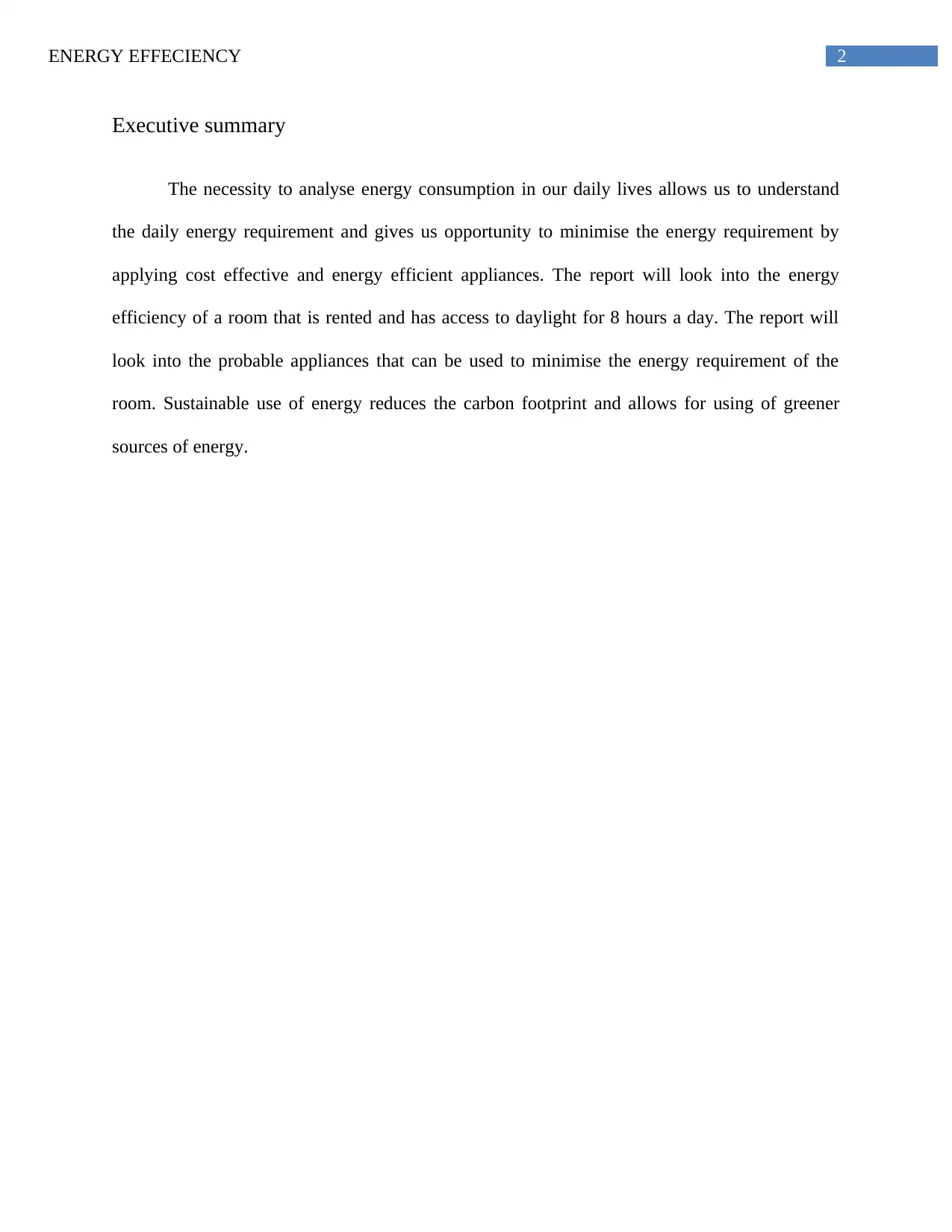
2ENERGY EFFECIENCY
Executive summary
The necessity to analyse energy consumption in our daily lives allows us to understand
the daily energy requirement and gives us opportunity to minimise the energy requirement by
applying cost effective and energy efficient appliances. The report will look into the energy
efficiency of a room that is rented and has access to daylight for 8 hours a day. The report will
look into the probable appliances that can be used to minimise the energy requirement of the
room. Sustainable use of energy reduces the carbon footprint and allows for using of greener
sources of energy.
Executive summary
The necessity to analyse energy consumption in our daily lives allows us to understand
the daily energy requirement and gives us opportunity to minimise the energy requirement by
applying cost effective and energy efficient appliances. The report will look into the energy
efficiency of a room that is rented and has access to daylight for 8 hours a day. The report will
look into the probable appliances that can be used to minimise the energy requirement of the
room. Sustainable use of energy reduces the carbon footprint and allows for using of greener
sources of energy.
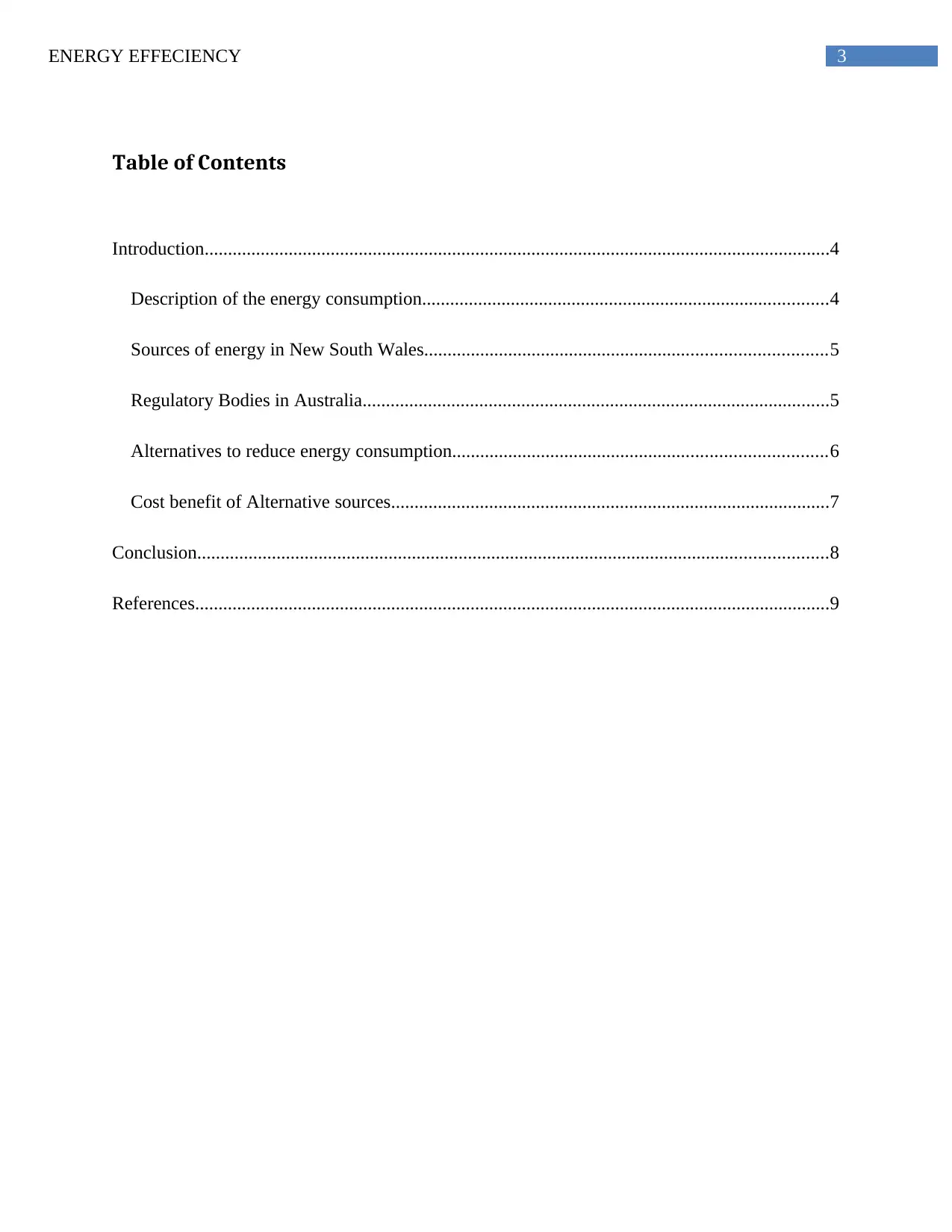
3ENERGY EFFECIENCY
Table of Contents
Introduction......................................................................................................................................4
Description of the energy consumption.......................................................................................4
Sources of energy in New South Wales......................................................................................5
Regulatory Bodies in Australia....................................................................................................5
Alternatives to reduce energy consumption................................................................................6
Cost benefit of Alternative sources..............................................................................................7
Conclusion.......................................................................................................................................8
References........................................................................................................................................9
Table of Contents
Introduction......................................................................................................................................4
Description of the energy consumption.......................................................................................4
Sources of energy in New South Wales......................................................................................5
Regulatory Bodies in Australia....................................................................................................5
Alternatives to reduce energy consumption................................................................................6
Cost benefit of Alternative sources..............................................................................................7
Conclusion.......................................................................................................................................8
References........................................................................................................................................9
⊘ This is a preview!⊘
Do you want full access?
Subscribe today to unlock all pages.

Trusted by 1+ million students worldwide
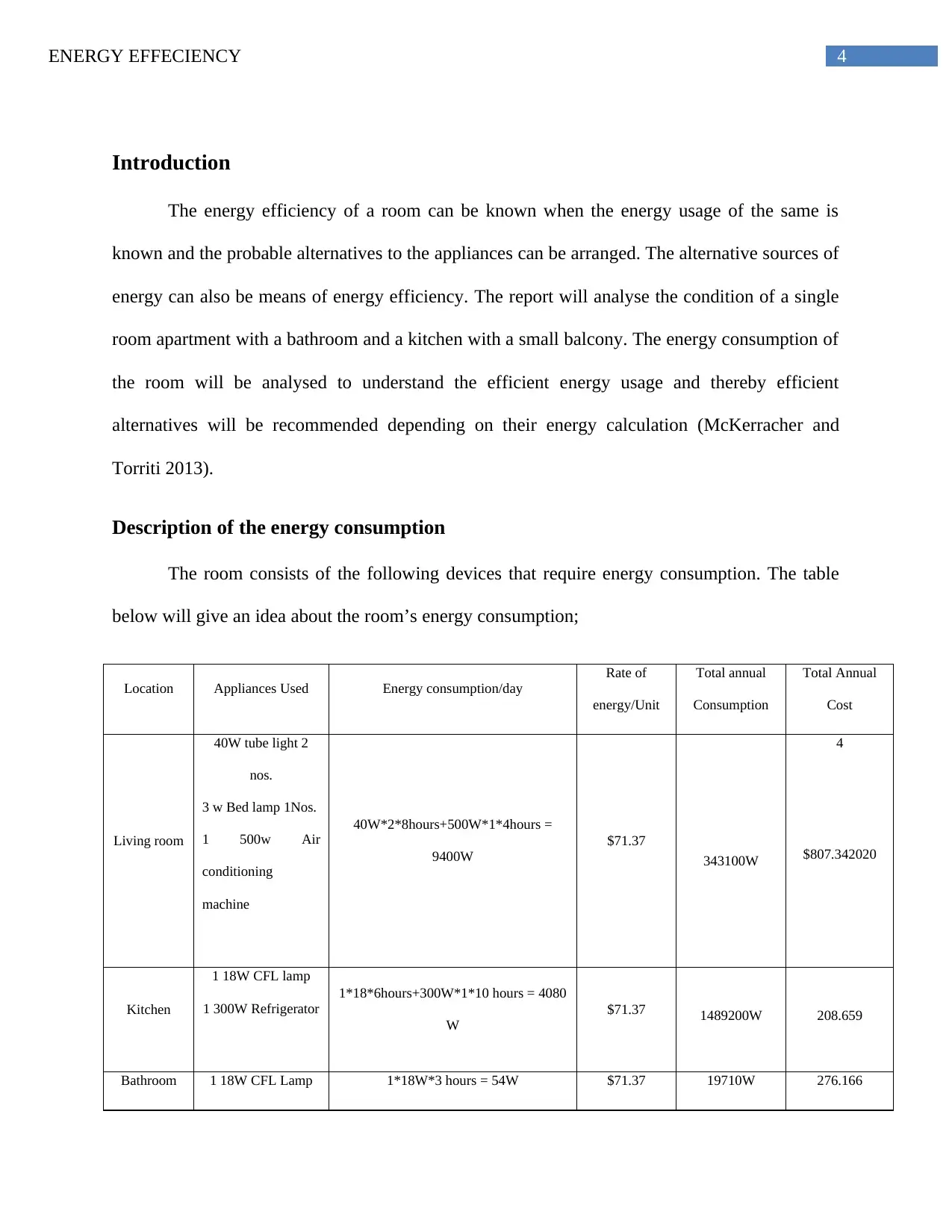
4ENERGY EFFECIENCY
Introduction
The energy efficiency of a room can be known when the energy usage of the same is
known and the probable alternatives to the appliances can be arranged. The alternative sources of
energy can also be means of energy efficiency. The report will analyse the condition of a single
room apartment with a bathroom and a kitchen with a small balcony. The energy consumption of
the room will be analysed to understand the efficient energy usage and thereby efficient
alternatives will be recommended depending on their energy calculation (McKerracher and
Torriti 2013).
Description of the energy consumption
The room consists of the following devices that require energy consumption. The table
below will give an idea about the room’s energy consumption;
Location Appliances Used Energy consumption/day
Rate of
energy/Unit
Total annual
Consumption
Total Annual
Cost
Living room
40W tube light 2
nos.
3 w Bed lamp 1Nos.
1 500w Air
conditioning
machine
40W*2*8hours+500W*1*4hours =
9400W
$71.37
343100W
4
$807.342020
Kitchen
1 18W CFL lamp
1 300W Refrigerator
1*18*6hours+300W*1*10 hours = 4080
W
$71.37 1489200W 208.659
Bathroom 1 18W CFL Lamp 1*18W*3 hours = 54W $71.37 19710W 276.166
Introduction
The energy efficiency of a room can be known when the energy usage of the same is
known and the probable alternatives to the appliances can be arranged. The alternative sources of
energy can also be means of energy efficiency. The report will analyse the condition of a single
room apartment with a bathroom and a kitchen with a small balcony. The energy consumption of
the room will be analysed to understand the efficient energy usage and thereby efficient
alternatives will be recommended depending on their energy calculation (McKerracher and
Torriti 2013).
Description of the energy consumption
The room consists of the following devices that require energy consumption. The table
below will give an idea about the room’s energy consumption;
Location Appliances Used Energy consumption/day
Rate of
energy/Unit
Total annual
Consumption
Total Annual
Cost
Living room
40W tube light 2
nos.
3 w Bed lamp 1Nos.
1 500w Air
conditioning
machine
40W*2*8hours+500W*1*4hours =
9400W
$71.37
343100W
4
$807.342020
Kitchen
1 18W CFL lamp
1 300W Refrigerator
1*18*6hours+300W*1*10 hours = 4080
W
$71.37 1489200W 208.659
Bathroom 1 18W CFL Lamp 1*18W*3 hours = 54W $71.37 19710W 276.166
Paraphrase This Document
Need a fresh take? Get an instant paraphrase of this document with our AI Paraphraser
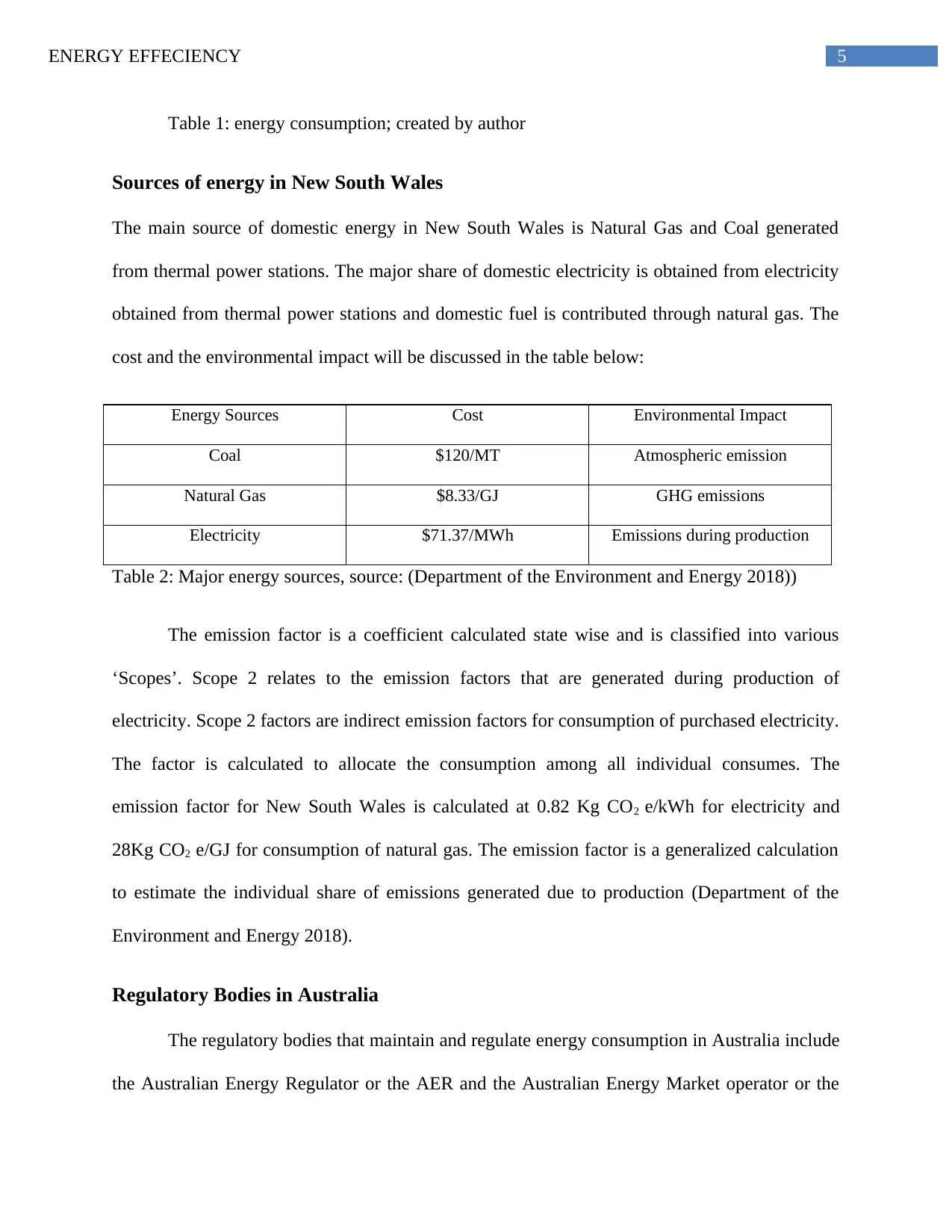
5ENERGY EFFECIENCY
Table 1: energy consumption; created by author
Sources of energy in New South Wales
The main source of domestic energy in New South Wales is Natural Gas and Coal generated
from thermal power stations. The major share of domestic electricity is obtained from electricity
obtained from thermal power stations and domestic fuel is contributed through natural gas. The
cost and the environmental impact will be discussed in the table below:
Energy Sources Cost Environmental Impact
Coal $120/MT Atmospheric emission
Natural Gas $8.33/GJ GHG emissions
Electricity $71.37/MWh Emissions during production
Table 2: Major energy sources, source: (Department of the Environment and Energy 2018))
The emission factor is a coefficient calculated state wise and is classified into various
‘Scopes’. Scope 2 relates to the emission factors that are generated during production of
electricity. Scope 2 factors are indirect emission factors for consumption of purchased electricity.
The factor is calculated to allocate the consumption among all individual consumes. The
emission factor for New South Wales is calculated at 0.82 Kg CO2 e/kWh for electricity and
28Kg CO2 e/GJ for consumption of natural gas. The emission factor is a generalized calculation
to estimate the individual share of emissions generated due to production (Department of the
Environment and Energy 2018).
Regulatory Bodies in Australia
The regulatory bodies that maintain and regulate energy consumption in Australia include
the Australian Energy Regulator or the AER and the Australian Energy Market operator or the
Table 1: energy consumption; created by author
Sources of energy in New South Wales
The main source of domestic energy in New South Wales is Natural Gas and Coal generated
from thermal power stations. The major share of domestic electricity is obtained from electricity
obtained from thermal power stations and domestic fuel is contributed through natural gas. The
cost and the environmental impact will be discussed in the table below:
Energy Sources Cost Environmental Impact
Coal $120/MT Atmospheric emission
Natural Gas $8.33/GJ GHG emissions
Electricity $71.37/MWh Emissions during production
Table 2: Major energy sources, source: (Department of the Environment and Energy 2018))
The emission factor is a coefficient calculated state wise and is classified into various
‘Scopes’. Scope 2 relates to the emission factors that are generated during production of
electricity. Scope 2 factors are indirect emission factors for consumption of purchased electricity.
The factor is calculated to allocate the consumption among all individual consumes. The
emission factor for New South Wales is calculated at 0.82 Kg CO2 e/kWh for electricity and
28Kg CO2 e/GJ for consumption of natural gas. The emission factor is a generalized calculation
to estimate the individual share of emissions generated due to production (Department of the
Environment and Energy 2018).
Regulatory Bodies in Australia
The regulatory bodies that maintain and regulate energy consumption in Australia include
the Australian Energy Regulator or the AER and the Australian Energy Market operator or the
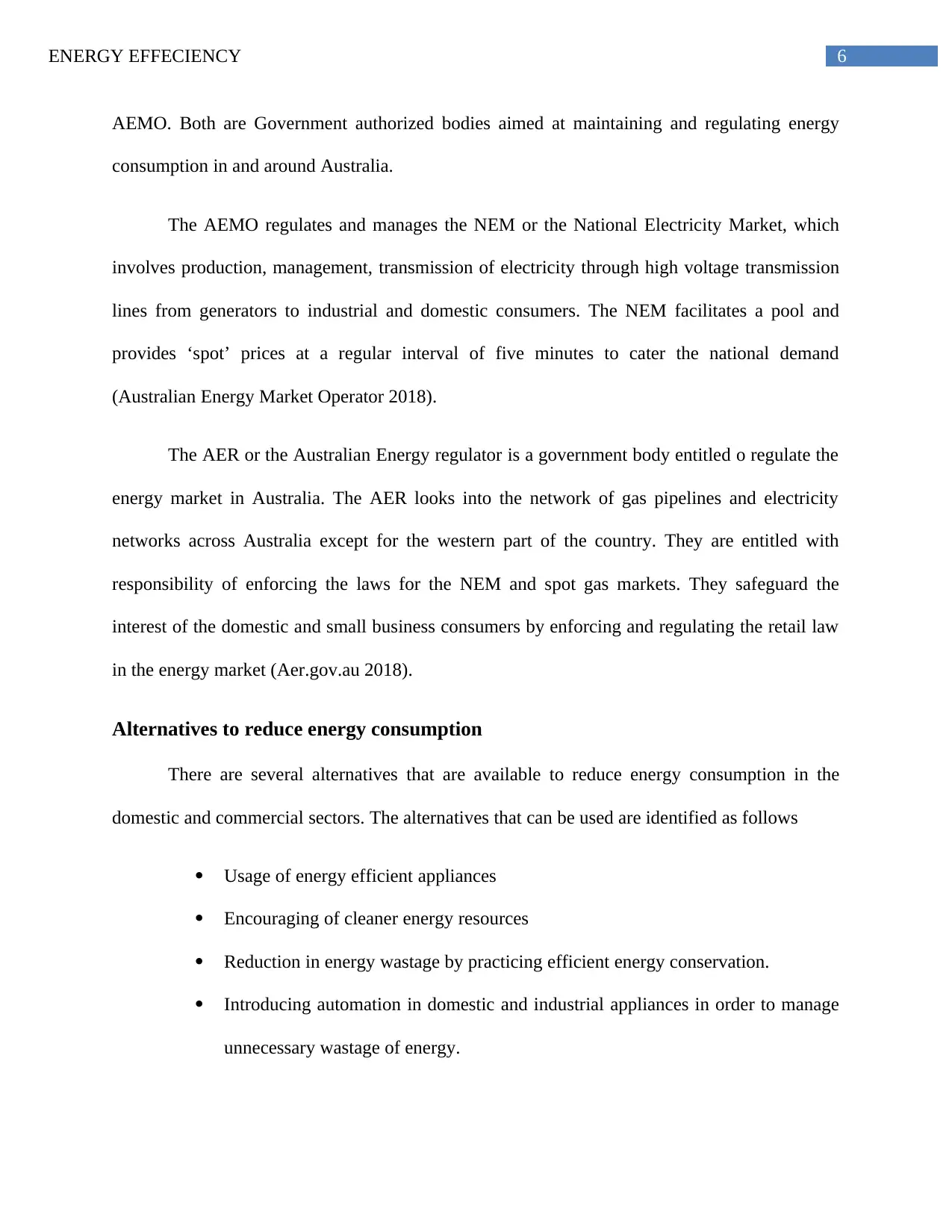
6ENERGY EFFECIENCY
AEMO. Both are Government authorized bodies aimed at maintaining and regulating energy
consumption in and around Australia.
The AEMO regulates and manages the NEM or the National Electricity Market, which
involves production, management, transmission of electricity through high voltage transmission
lines from generators to industrial and domestic consumers. The NEM facilitates a pool and
provides ‘spot’ prices at a regular interval of five minutes to cater the national demand
(Australian Energy Market Operator 2018).
The AER or the Australian Energy regulator is a government body entitled o regulate the
energy market in Australia. The AER looks into the network of gas pipelines and electricity
networks across Australia except for the western part of the country. They are entitled with
responsibility of enforcing the laws for the NEM and spot gas markets. They safeguard the
interest of the domestic and small business consumers by enforcing and regulating the retail law
in the energy market (Aer.gov.au 2018).
Alternatives to reduce energy consumption
There are several alternatives that are available to reduce energy consumption in the
domestic and commercial sectors. The alternatives that can be used are identified as follows
Usage of energy efficient appliances
Encouraging of cleaner energy resources
Reduction in energy wastage by practicing efficient energy conservation.
Introducing automation in domestic and industrial appliances in order to manage
unnecessary wastage of energy.
AEMO. Both are Government authorized bodies aimed at maintaining and regulating energy
consumption in and around Australia.
The AEMO regulates and manages the NEM or the National Electricity Market, which
involves production, management, transmission of electricity through high voltage transmission
lines from generators to industrial and domestic consumers. The NEM facilitates a pool and
provides ‘spot’ prices at a regular interval of five minutes to cater the national demand
(Australian Energy Market Operator 2018).
The AER or the Australian Energy regulator is a government body entitled o regulate the
energy market in Australia. The AER looks into the network of gas pipelines and electricity
networks across Australia except for the western part of the country. They are entitled with
responsibility of enforcing the laws for the NEM and spot gas markets. They safeguard the
interest of the domestic and small business consumers by enforcing and regulating the retail law
in the energy market (Aer.gov.au 2018).
Alternatives to reduce energy consumption
There are several alternatives that are available to reduce energy consumption in the
domestic and commercial sectors. The alternatives that can be used are identified as follows
Usage of energy efficient appliances
Encouraging of cleaner energy resources
Reduction in energy wastage by practicing efficient energy conservation.
Introducing automation in domestic and industrial appliances in order to manage
unnecessary wastage of energy.
⊘ This is a preview!⊘
Do you want full access?
Subscribe today to unlock all pages.

Trusted by 1+ million students worldwide
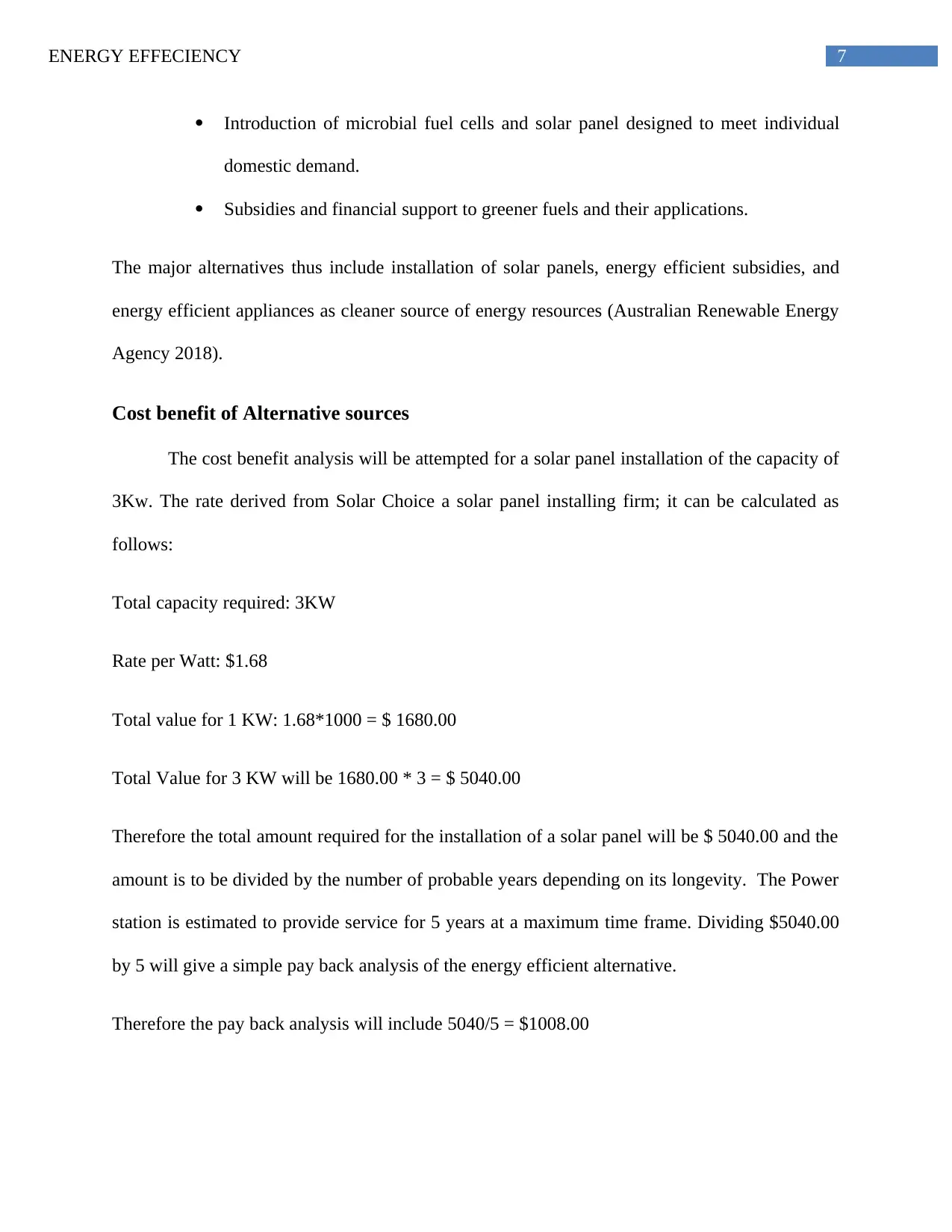
7ENERGY EFFECIENCY
Introduction of microbial fuel cells and solar panel designed to meet individual
domestic demand.
Subsidies and financial support to greener fuels and their applications.
The major alternatives thus include installation of solar panels, energy efficient subsidies, and
energy efficient appliances as cleaner source of energy resources (Australian Renewable Energy
Agency 2018).
Cost benefit of Alternative sources
The cost benefit analysis will be attempted for a solar panel installation of the capacity of
3Kw. The rate derived from Solar Choice a solar panel installing firm; it can be calculated as
follows:
Total capacity required: 3KW
Rate per Watt: $1.68
Total value for 1 KW: 1.68*1000 = $ 1680.00
Total Value for 3 KW will be 1680.00 * 3 = $ 5040.00
Therefore the total amount required for the installation of a solar panel will be $ 5040.00 and the
amount is to be divided by the number of probable years depending on its longevity. The Power
station is estimated to provide service for 5 years at a maximum time frame. Dividing $5040.00
by 5 will give a simple pay back analysis of the energy efficient alternative.
Therefore the pay back analysis will include 5040/5 = $1008.00
Introduction of microbial fuel cells and solar panel designed to meet individual
domestic demand.
Subsidies and financial support to greener fuels and their applications.
The major alternatives thus include installation of solar panels, energy efficient subsidies, and
energy efficient appliances as cleaner source of energy resources (Australian Renewable Energy
Agency 2018).
Cost benefit of Alternative sources
The cost benefit analysis will be attempted for a solar panel installation of the capacity of
3Kw. The rate derived from Solar Choice a solar panel installing firm; it can be calculated as
follows:
Total capacity required: 3KW
Rate per Watt: $1.68
Total value for 1 KW: 1.68*1000 = $ 1680.00
Total Value for 3 KW will be 1680.00 * 3 = $ 5040.00
Therefore the total amount required for the installation of a solar panel will be $ 5040.00 and the
amount is to be divided by the number of probable years depending on its longevity. The Power
station is estimated to provide service for 5 years at a maximum time frame. Dividing $5040.00
by 5 will give a simple pay back analysis of the energy efficient alternative.
Therefore the pay back analysis will include 5040/5 = $1008.00
Paraphrase This Document
Need a fresh take? Get an instant paraphrase of this document with our AI Paraphraser
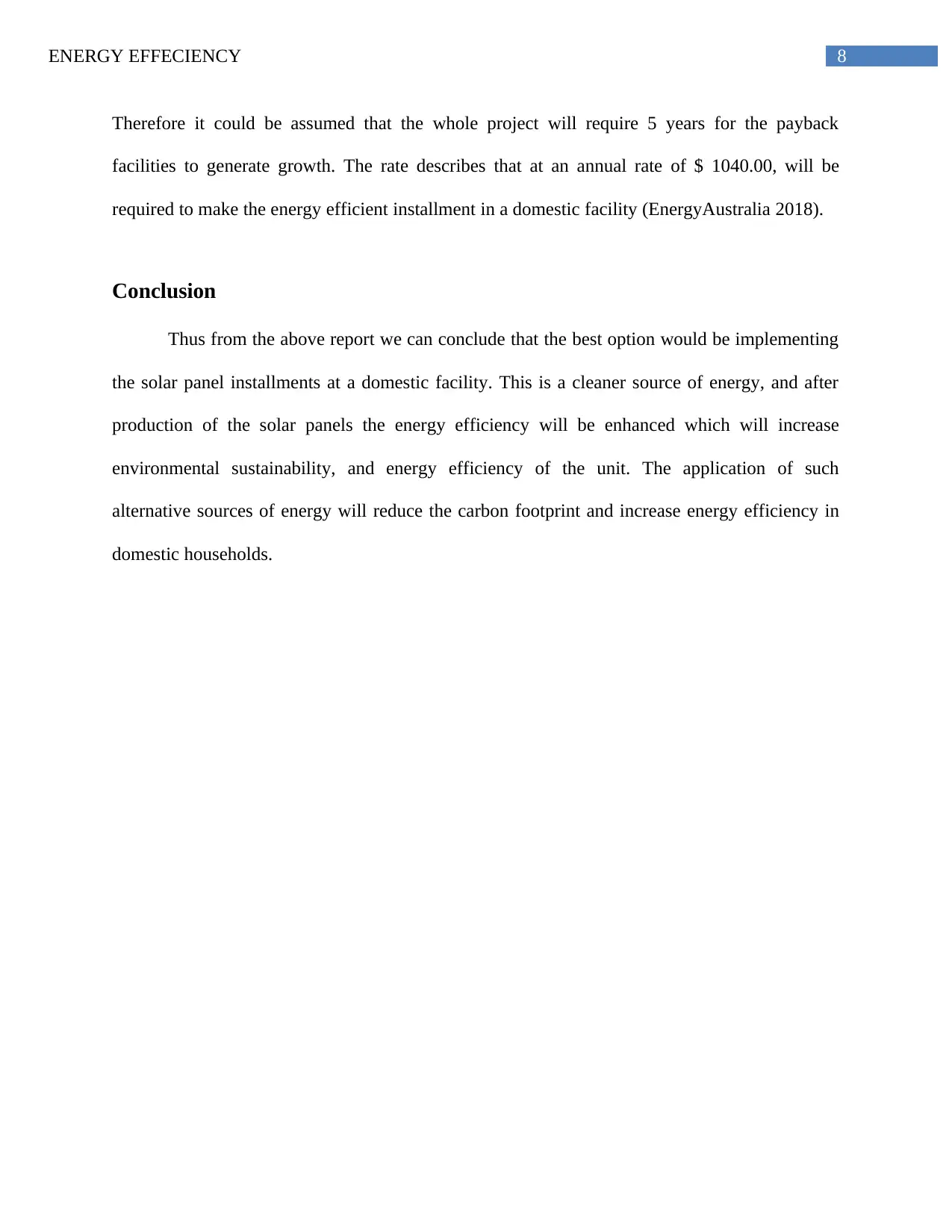
8ENERGY EFFECIENCY
Therefore it could be assumed that the whole project will require 5 years for the payback
facilities to generate growth. The rate describes that at an annual rate of $ 1040.00, will be
required to make the energy efficient installment in a domestic facility (EnergyAustralia 2018).
Conclusion
Thus from the above report we can conclude that the best option would be implementing
the solar panel installments at a domestic facility. This is a cleaner source of energy, and after
production of the solar panels the energy efficiency will be enhanced which will increase
environmental sustainability, and energy efficiency of the unit. The application of such
alternative sources of energy will reduce the carbon footprint and increase energy efficiency in
domestic households.
Therefore it could be assumed that the whole project will require 5 years for the payback
facilities to generate growth. The rate describes that at an annual rate of $ 1040.00, will be
required to make the energy efficient installment in a domestic facility (EnergyAustralia 2018).
Conclusion
Thus from the above report we can conclude that the best option would be implementing
the solar panel installments at a domestic facility. This is a cleaner source of energy, and after
production of the solar panels the energy efficiency will be enhanced which will increase
environmental sustainability, and energy efficiency of the unit. The application of such
alternative sources of energy will reduce the carbon footprint and increase energy efficiency in
domestic households.
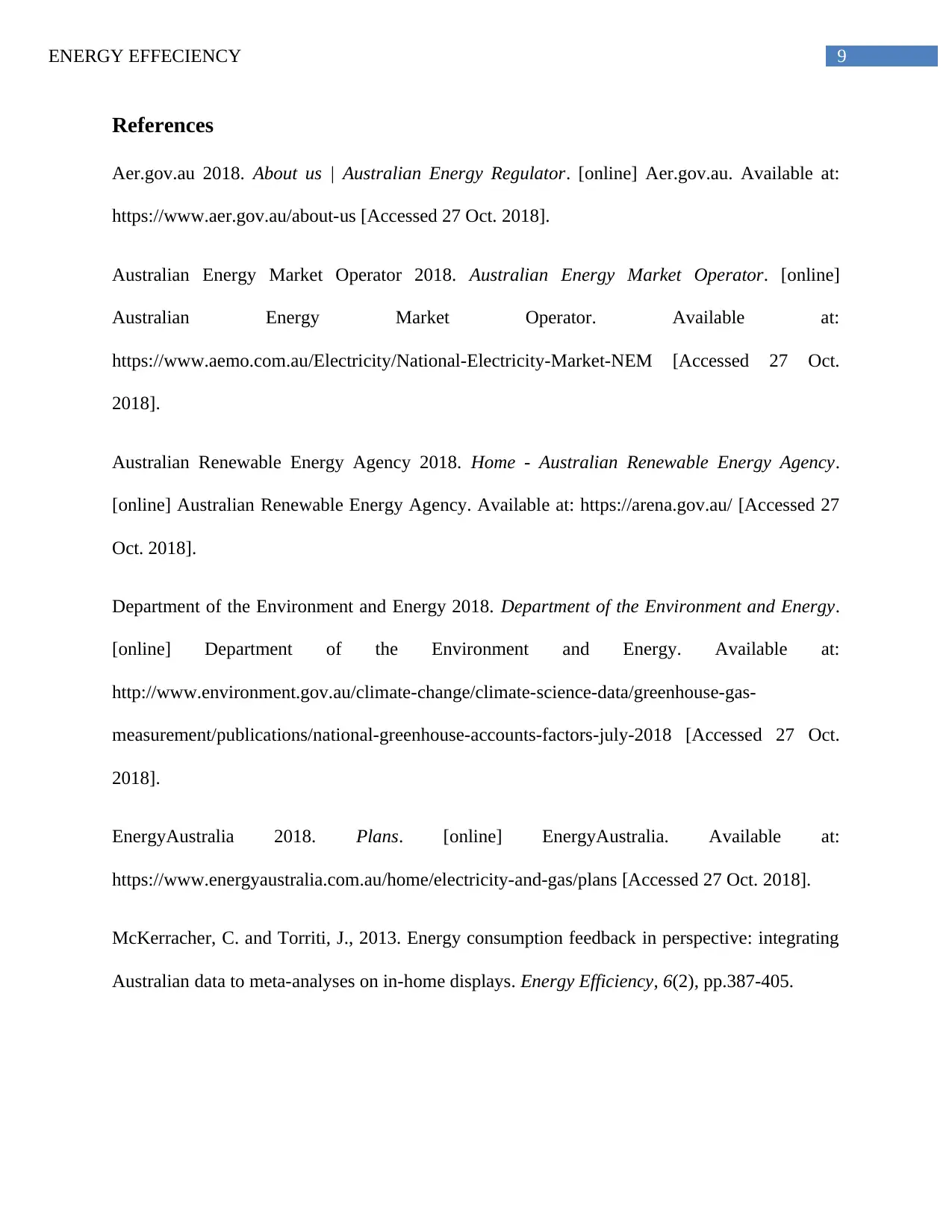
9ENERGY EFFECIENCY
References
Aer.gov.au 2018. About us | Australian Energy Regulator. [online] Aer.gov.au. Available at:
https://www.aer.gov.au/about-us [Accessed 27 Oct. 2018].
Australian Energy Market Operator 2018. Australian Energy Market Operator. [online]
Australian Energy Market Operator. Available at:
https://www.aemo.com.au/Electricity/National-Electricity-Market-NEM [Accessed 27 Oct.
2018].
Australian Renewable Energy Agency 2018. Home - Australian Renewable Energy Agency.
[online] Australian Renewable Energy Agency. Available at: https://arena.gov.au/ [Accessed 27
Oct. 2018].
Department of the Environment and Energy 2018. Department of the Environment and Energy.
[online] Department of the Environment and Energy. Available at:
http://www.environment.gov.au/climate-change/climate-science-data/greenhouse-gas-
measurement/publications/national-greenhouse-accounts-factors-july-2018 [Accessed 27 Oct.
2018].
EnergyAustralia 2018. Plans. [online] EnergyAustralia. Available at:
https://www.energyaustralia.com.au/home/electricity-and-gas/plans [Accessed 27 Oct. 2018].
McKerracher, C. and Torriti, J., 2013. Energy consumption feedback in perspective: integrating
Australian data to meta-analyses on in-home displays. Energy Efficiency, 6(2), pp.387-405.
References
Aer.gov.au 2018. About us | Australian Energy Regulator. [online] Aer.gov.au. Available at:
https://www.aer.gov.au/about-us [Accessed 27 Oct. 2018].
Australian Energy Market Operator 2018. Australian Energy Market Operator. [online]
Australian Energy Market Operator. Available at:
https://www.aemo.com.au/Electricity/National-Electricity-Market-NEM [Accessed 27 Oct.
2018].
Australian Renewable Energy Agency 2018. Home - Australian Renewable Energy Agency.
[online] Australian Renewable Energy Agency. Available at: https://arena.gov.au/ [Accessed 27
Oct. 2018].
Department of the Environment and Energy 2018. Department of the Environment and Energy.
[online] Department of the Environment and Energy. Available at:
http://www.environment.gov.au/climate-change/climate-science-data/greenhouse-gas-
measurement/publications/national-greenhouse-accounts-factors-july-2018 [Accessed 27 Oct.
2018].
EnergyAustralia 2018. Plans. [online] EnergyAustralia. Available at:
https://www.energyaustralia.com.au/home/electricity-and-gas/plans [Accessed 27 Oct. 2018].
McKerracher, C. and Torriti, J., 2013. Energy consumption feedback in perspective: integrating
Australian data to meta-analyses on in-home displays. Energy Efficiency, 6(2), pp.387-405.
⊘ This is a preview!⊘
Do you want full access?
Subscribe today to unlock all pages.

Trusted by 1+ million students worldwide
1 out of 9
Related Documents
Your All-in-One AI-Powered Toolkit for Academic Success.
+13062052269
info@desklib.com
Available 24*7 on WhatsApp / Email
![[object Object]](/_next/static/media/star-bottom.7253800d.svg)
Unlock your academic potential
Copyright © 2020–2026 A2Z Services. All Rights Reserved. Developed and managed by ZUCOL.





